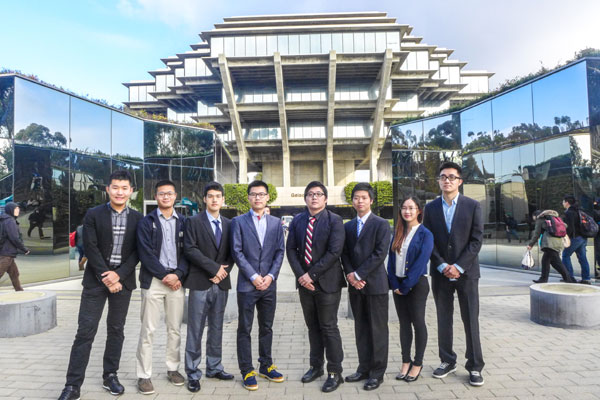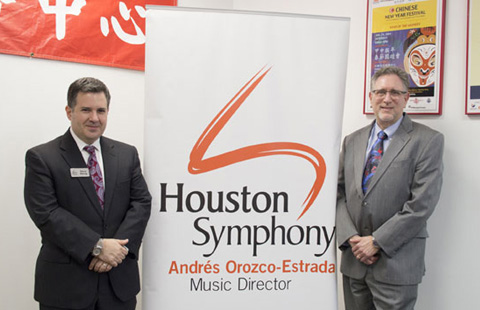Chinese students launch MOOC
Updated: 2015-01-21 11:06
By HUA SHENGDUN in Washington(China Daily USA)
|
||||||||
 |
|
(From left) Jiang Zidong, Technonoly Department of a MOOC company Moorgoo.com; Chen Nan, Technology Department;Tao Zijian Tao, Technology Department;Li Si, Chief Information Officer; He Tian, Chief Executive Officer; He Mingxuan, Chief Financial Officer;Liu Siyu Liu, Marketing Director; and Li Xueyang Li, Technology Department ahead of the Geisel Library at University Of California, San Diego, the groups' alma mater, on Jan 15, a memorable day when the website was officially online. Provided to China Daily. |
The hit Chinese film American Dreams in China came true again last week when eight Chinese students started an online education business in California last week.
Moorgoo.com, a MOOC (massive open online course) website for Chinese students in the US, was launched by an octet of Chinese students at the University of California, San Diego (UCSD) on Jan 15.
MOOCs first grabbed the spotlight in 2011 and have grown to a global trend from North America and later Europe, Australia, Latin America and Asia. Tsinghua University, Peking University, and National Taiwan University have all joined the movement.
"After watching the film American Dreams in China, we came up with a similar idea, why not do something cool about online education for Chinese students in the US?" He Mingxuan, a UCSD senior and CFO of Moorgoo.com, told China Daily.
American Dreams in China, based on the true story of three students at Beijing New Oriental School, the largest English language school in China, traced the history of the language education industry back to the 1980s.
Yu Minhong, Xu Xiaoping, and Wang Qiang, the main characters of the film, made their first trial into English language training in the late 1980s and early 1990s, when study overseas became a wave in China.
Inspired by the entrepreneurial story of 30 years ago, five computer science majors and three with financial backgrounds started to write their own chapter of the American dream in China in June 2014.
"We hope to provide a platform for Chinese students, even local students in UCSD, to better manage their time in learning and keep a balance both in and out of class," He said.
Courses on calculus, economics, computer science, and chemistry are provided on the website, along with tutoring services aimed specifically at Chinese students who feel overburdened with homework.
"It also offers courses on English testing," He Tian, CEO of Moorgoo said. "Extra courses such as physics, biology and psychology will be logged on this semester later."
International students with scores lower than 680 in SAT writing session will get English test when entering into UCSD.
He said the on-campus online education service will soon roll out into other schools in southern California and other areas of the US this season, giving more access for Chinese students.
So as not to leave anyone out because of their economic status, He said there was no cost for the video.
"However, we are thinking of charging an extremely fair price on the web which every student could afford," he added.
2012 became "the year of the MOOC", as several well-financed providers emerged, including Coursera, Udacity and edX, associated with top universities such as Harvard, Stanford and the U Penn, according to The New York Times.
The flipped classroom model with the boom of MOOCs will help "reform the education method", Shanghai Education Commission official Ni Minjing said last year.
"On this platform, students can finish some of their study tasks," Ni said. "This may help improve students' interest in learning."
The courses have become an "important supplement to classroom learning and a tool for professional development", said Jeffrey Selingo, author of MOOC U: Who's Getting the Most Out of Online Education and Why.
"Information technology has penetrated into the traditional education system, bringing more advantages to students," Li Si, senior and Moorgoo's CIO, told China Daily.
"So it's important to realize that we Chinese students should be smart at learning, be more effective and have spare time to experience and discover more in the US," Li said. "We need a change."
Overseas students in the US have reached a high of about 900,000, a 8.1 percent growth compared to 2013, according to the 2014 Open Doors Report by the Institute of International Education.
About 270,000 Chinese students were included, accounting for one third of the total number and six times the number a decade ago.
Some feedback is displayed on Moorgoo.com's website.
"The videos on Moorgoo.com helped me and my friends in our exams, and the experience of watching them in the library impressed me as well," one post said.
"Being a teacher at Moorgoo.com, I think it's very meaningful for us to help those in need by teaching them what I have acquired and make a profit for me too," another post said.
Learning from management and cooperation models in the film American Dreams in China, He Mingxuan said there was still plenty of room to improve.
"We still face challenges in financing, technology solutions and management," He said. "But we ourselves also learn a lot by jumping each hurdle in our way."
Sheng Yang in Washington contributed to this story.
- Victims' families of Shanghai stampede to be compensated
- Chinese reflect on education after girl forces mom to abort
- Shanghai govt releases report on stampede tragedy
- Fake condoms, Viagra, seized and online network shut down
- Joy and sorrow of monkey trainers
- Chinese premier arrives in Switzerland for Davos forum, working visit

 Wuhan to get green center done by US firm
Wuhan to get green center done by US firm
 What Obama proposes in State of the Union Address
What Obama proposes in State of the Union Address
 Cuba, US ready for historic talks on restoring ties
Cuba, US ready for historic talks on restoring ties
 Doctor shot inside a Boston hospital
Doctor shot inside a Boston hospital
 US firm designing green center in China
US firm designing green center in China
 Forbidden City orchestra to play Houston
Forbidden City orchestra to play Houston
 Chinese premier arrives in Switzerland for Davos forum, working visit
Chinese premier arrives in Switzerland for Davos forum, working visit
 7 things you may not know about Major Cold
7 things you may not know about Major Cold
Most Viewed
Editor's Picks

|

|

|

|

|

|
Today's Top News
Victims' families of Shanghai stampede to be compensated
Oil-price drop spurs Chinese to invest in Texas
IMF's China outlook to affect others
Obama seeks backing of force on ISIS
Wuhan to get green center done by US firm
Chinese orchestra to play Houston
Chinese students launch massive online course
Obama calls on Congress to authorize force against IS
US Weekly

|

|








